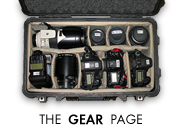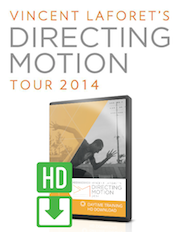How to succeed as a creative long term: know your C.O.D.B.
There are four letters out there (an acronym to be exact) that have the potential to literally shape your future as a creative, and to determine whether or not you will be able to stay in business long term.
As simple as this formula is, and as basic as it will appear to you once I explain it, I am constantly surprised (shocked to be honest!) at how few people pay attention to this simple number. Even veteran freelancers don’t seem to know what their daily C.O.D.B. number is.
C.O.D.B stands for "Cost of Doing Business." Basically it’s a number that represents what it costs you to operate your business for every day that you work.
On a basic level, you add up all of your purchases and expenses to run your business, as well as your salary (I suggest you add your salary, but some people don’t) and divide that by the total number of days you expect to work each year. That will give you a number that is the MINIMUM you must make each day to BREAK EVEN. If you make more per day on average than your C.O.D.B., you are profitable. If you match your C.O.D.B but work fewer days than what your expected, your business is in the red, and your on a path to being out of business…
What has amazed me time after time is how few of my colleagues know what their number is, and how that in turn makes it very difficult for them to grow their business over time – let alone what to charge their clients.
You should know this number by heart as it should help you determine the minimum rates you need to charge your clients on a job per WORKING day, to stay solvent as a business. Keep in mind that if you get paid per SHOOT day – and don’t get paid for treatments, conference calls, research, prep and post – you need to cover ALL of those days in your SHOOT DAY FEE of course. In other words, if you get paid 3 shooting day rates, but you actually worked a total of 12 days between pitch, prep, shoot, and post – you need to QUADRUPLE your DAY RATE (or daily C.O.D.B. day rate) to break even for those 3 shooting days you are actually being paid for.
So here’s how you calculate it:
You can start on a spreadsheet or with a simple piece of paper, or here’s a link to an Excel Spreadsheet I’m putting up for you to fill out on your own with your own expenses, categories, and desired salary.
Start by listing all of your business expenses per year, your cell phone service, the gear that you buy, the repairs, the insurance, etc. Think about EVERYTHING you buy for your business on a yearly basis. And if you buy a camera for example, divide that by the number of years you expect to have it in service, the same goes for a computer, and add that final number to your spreadsheet.
Then don’t forget to add the salary you pay yourself – this is critical. The salary is something that should be able to cover your rent, clothing, utilities, etc. Oh and don’t forget about taxes on that salary you’re giving yourself. If you need $3,000 to live on a month, remember that that’s AFTER taxes. Depending on your tax bracket you should add the correct tax percentage on top of that to determine the salary you need to pay yourself each month BEFORE taxes.
Once you get a little more advanced, I suggest you put some additional categories in there: such as retirement money, and savings. We’re leaving that out for now – but you shouldn’t! Oh: and while freelancers don’t generally pay themselves when they take vacation time… consider taking that into account at some point too…
This might be getting a bit complicated for some – so below is a visual breakdown that I put together. I added a bunch of categories on there, many of which you may not have/use in your own business, but I wanted to err on the side of adding too much so that you can see how quickly things can add up. I also picked a "standard" salary and expenses (there is no such thing) for someone working in a mid to large city in the U.S.
To some of you these will be exorbitant numbers, to others this will be very low. It’s all relative. Frankly I made quite a few up. As long as you get the principle we’re good. $70K is a darn nice salary in many parts of the United States and definitely the world. If you live in New York City on the other hand… it’s difficult to live on such a salary for many due to the high costs of living and exorbitant real estate. If you have a family with children $70K is difficult in many parts of the U.S. It seemed like a good salary goal to use here for those reasons.
The numbers below assume you work 200 days per year. The average full-time person works 260 days not counting vacation/holidays (5 days a week times 52 weeks.) But very few freelancers work back to back 5 days a week – 200 is more realistic. That’s what the "daily total" is based on in the chart below. Truth be told… when you consider the amount of days we DON’T get paid for on a project… 100 days a year of "paid" day rates is probably more realistic for many of you… so you can go ahead and double most of the numbers below if you find that that applies to you.
The graph assumes you buy yourself a professional video camera that you will use over 2-4 years (depending on the price) before it becomes outdated, as well as lenses, accessories etc. It’s very difficult to guess what everyone spends – but the point here was for me to add as many categories of things we tend to "forget." We are all well aware of our big purchases, but we tend to forget how small purchases and monthly expenses quickly add up. We easily forget about CF cards, cables, hard drives, subscriptions let alone business meals.
I’ve added a salary of $70,000 a year here, and I also snuck health insurance in there as well (this will most likely be part of your PERSONAL not business expenses of course but I’m trying to keep everything as simple as possible for now.) That means that you’d have just under $4,000 per month to live on depending on your federal, state and local taxes which vary of course.
I’ve added little things like holiday cards, stationary, and the costs of promotion in there as well such as cutting a new reel every year. I’ve also added a personal project in there that you do once a year, just to give yo an idea of setting money aside for that as well. I’ve also gone ahead an assumed you have a business vehicle in there. You obviously will have to deduct only part of the vehicle you use for business and what part you use for personal if this not a vehicle purely used for business of course.

So what does this mean? Well, if you work 200 days a year, and you charge $500/day and your expenses and salary are equals to those listed above – you’re losing money. (You need to charge the extra $145/day to bring the $500 rate up to your $645 C.O.D.B. number [two lines up from bottom right of graph above] to break even.) If you make an average of $750 per day – great! You’re making money! But keep in mind the numbers above are your cost numbers. You won’t actually be making that extra $250/day – as you’ll have to pay taxes on that (let’s say 33% for now, leaving you with a net profit of $165 for that day.)
If you make $400 on average and work 120 days a year… you’re in real trouble. The solution: work more days, get a higher rate or… buy less gear, spend less in general, and/or pay yourself a smaller salary.
But here’s where it gets interesting. If you have a bad month or year (or a normal one depending on how much you work!) or perhaps you get injured or sick, and only work 150 days per year – your daily C.O.D.B. jumps to $859.60.
So why does this matter?
Well let’s say a client calls you and says they can only pay you $1000 for a job that involves 3 days of shooting and an edit. Based on the numbers above you need to make $1,935 to break even right? You’re short $935 on this job and are actually LOSING money on it… you’ll have to make it up on future jobs which is hard.
But think about it some more: they want you to edit it right? And you’ll likely have to do a minimum of one day at least of prep right? In fact the reality is that you’ll do a few days of phone calls and e-mails back and forth to write a proposal and budget and to talk things over with the client. Let’s say 3 days for now. You then shoot for another 3. And then comes the EDIT. And that takes your 2 days. But after two rounds of "revisions" with your client in terms of small changes, you’re up to a total of say 4 full days for the edit. You’re spent a total of 10 days on the job now. You should have billed $6,450 dollars for the job – but only got pay $1,000.
And now you find yourself having to make up $5,450 on your OTHER 190 work days left for the rest of your year! You LOST MORE THAN 5 GRAND ON THE JOB!
And God Forbid… you break a piece of equipment on the job and have a $500 deductible… add that to the mix. You get the idea…
This is how freelancers are getting burned every day. More often than not: they’re doing it to themselves! And I can’t tell you the number of times I’ve had to counsel new freelancers on this fact… maybe a few dozen times. And they’re always so shocked to hear the numbers once we go through this exercise. They inherently know they’re not making money on the job after they get to the 1st round of "revisions" on their edit. But they have no idea that they subsidized the job with $5,450 of their own money…
When a client asks you to shoot something "as a favor" for less than your C.O.D.B. rate, consider it carefully. Sometimes it will lead to future jobs – it absolutely might – and so you can decide to go for it! Another way to look at it though is that you’re setting up to be the person they go to for that type of budget forever… It might actually be better for you not to charge them anything at all – explaining to them that you’re willing to do a simple job for them in the hopes of getting a larger campaign… so that you don’t set yourself up as the "cheap"person forever. This is a complex concept and dangerous and I’m not going to dive into it now. I just want you to think about it…
Another good way to look at this is for example, is the cost of a Camera. Let’s say you buy a fancy $12,000 camera package for a DSLR, filters, lenses, etc etc. You expect that it will last you 4 years. So you need to make $3,000 with that camera package every year, or $15 per day (on a 200 work day year) every day you take it out to shoot with. If you make any less, you’re going to need to make that up somewhere else… But keep in mind you should be generating a PROFIT with that camera – so that you have enough money saved up (after taxes on the profits are taken away by Uncle Sam) to buy a new one in 4 years or less… This is another unfortunate mistake people make.
Therefore when you buy that $2,000 MacBook … if you know you’re realistically going to use if for 2 years because you like to upgrade regularly… you’ve got to make $1,000 a year with it minimum to pay it off – or $84 per month just to cover that cool little laptop. Ask yourself: do you (or does your business) REALLY need it?
The most important thing to take away from this is that you need to be a responsible "professional" if you will, and know your C.O.D.B. when bidding on a job.
The truth is, everyone’s C.O.D.B. is different – and that’s absolutely fine and that will always be the case.
The irresponsible thing is no knowing what your number is.
Why?
When another colleague of yours bids $6,450 for the same job you’re being asked to shoot for $1,000, and you accept it, you are not only doing yourself a disservice, but also the fellow freelancer you are bidding against – not to mention the industry.
This isn’t a discussion on setting higher rates, or what rates "should be," those will always be different for people of different levels of experience and skill levels. This is a discussion on being responsible enough to know your own C.O.D.B. so that you are making good decisions on what to bid on jobs and when you’re actually losing money on a job, versus making a profit.
One key factor to leave you with: your C.O.D.B. is your break even point. If you add your salary in there it’s the base number you need to make per day to cover your personal living expenses as well as your business expenses. Consider it a starting point – not a goal. Your goal should of course be to MAKE A PROIFT above you C.O.D.B. so that you can invest in more equipment, hire more employees, promote yourself more effectively, have some padding to take more creative jobs that can’t meet your C.O.D.B. because they truly don’t have a budget, and put money in savings – to GROW.
To that point I personally add categories in there for "retirement," growth, and savings – that is part of my C.O.D.B. Because once again, remember that on every dollar of profit you make beyond this, a nice chunk of it will go to taxes of course.
Hopefully the next time you get asked to shoot something for $300 for a day, you’ll realize that it’s not $300 of profit that you’re making, but actually a $345 LOSS on the day on your job if you want to keep your business running long term with the budget set above.
So find out what your C.O.D.B. is … respect it, and you should be around for years to come.
I hope this helps a few of you out there! I can tell you that if we all know our C.O.D.B. and educate our clients on what it costs us to stay in business, we’ll all benefit in the long term.
Here is another C.O.D.B. Calculator from the NPPA and I recommend you read John Harrington’s Book "Best Business Practices for Photographers" to find out more about business related information that applies to most freelancers out there.













Great post! I’ve been freelance for about 3 years now. It’s been a struggle to get up and running, which isn’t helped by the fact that I’m terrible with money! This is extremely useful!!!
Vincent Laforet Reply:
August 1st, 2013 at 2:36 am
Many creatives are terrible with money unfortunately…. either because they haven’t been educated on how to finance a business…or because for them it’s about the “art.” And unfortunately a lot of clients take advantage of this fact…
Hi Vincent
Supper article. I was aware of C.O.D.B, your post explains process of charging clearly and simply. I think a lot of clients fail to recognize this and in recent years have used the recession as an excuse to drive down rates, placing photographers in a lose lose situation when it comes to bidding for work.
Great post Vincent, thankyou very much. I have just worked through my CODB, printed it off and fixed it to the wall in my office, I had previously been 2nd guessing what I thought the job should be paying vs what I thought the client would be prepared to pay.
I do have one question though if you have a moment, how would licensing factor into your day rate, would this day rate then have additional licensing cost related to the type of job or would the over all cost of the job including licensing divided by the days on the job have to meet the CODB?
Thanks.
Vincent Laforet Reply:
August 1st, 2013 at 10:19 am
Licensing is your PROFIT my friend… be reasonable. But CODB is just a base remember…
John Harrington’s book was for me – and should be for anybody starting out – be a big eye opener… don’t get ripped off, creatives always undervalue their input/value!
Can I share this on my blog- Of course giving you fill credit and link back to your blog. This a GREAT read..being “new” to the business.. this has been extremely helpful! Thank you xoxo Monica
Vincent Laforet Reply:
August 1st, 2013 at 10:18 am
Yes you can – and you can use the first half and link the second half to the blog.
I think you made a mistake at “Office Rent”. It says $1K/mo. but the yearly total is $1,200. And that changes the (daily) grand total a lot! You have to make over $700 per day.
Vincent Laforet Reply:
August 1st, 2013 at 10:17 am
Ah yes! You have the excel sheet then to do your own calculations – this was just a quick example.
Thanks for the post. I am still struggling with this as I have had my portrait business up and running for a few years and I have been trying to find a balance for what I charge verses what I pay out for my business. Thanks for the tips.
One of the best posts on pricing i have ever read. Numbers will vary, but excellent work. thank you..It.should be mandatory read for anyone starting a creative business!
Vincent,
Really appreciate this information. I won’t speak for us all, but I’m sure the financials are often overlooked when working in photography or many other creative fields … but here’s my question to you.
I’ve done the hard work … crunched numbers and made my purchases with out piling on debt. Although still a new face in photography (shooting for 7 but only 4 years professionally) I definitely have a considerable amount of confidence in my skills and execution. I can work with a client towards a creative goal while injecting my style into a project. I work well on set with others and know when to take control of my shoot while remaining professional. I’m up to date on tech and always building my knowledge of the latest lighting techniques or retouching practices. These qualities I feel are paramount to what being a professional is all about.
So why when it comes to explaining these great costs spent on my part (time, scouting, retouching, sourcing other professionals, hiring assistants, countless hours researching on lighting techniques and the like) am I getting passed by from potential clients?
Furthermore, how can I stay afloat in this business when I’m either turning away projects because they pay too little or having to complete projects at a constant loss?
I’ve gone through many client meetings that end like this …
“We love your work, and we’d love to work with you … but we can only afford to pay you $300 for this job.”
So the dichotomy of having to tell myself “I need $300 to be able to eat and help pay my bills this month” paired with “I can’t believe I’m only getting paid $300 when I know I’m really worth more” is simply mind-boggling. I think a lot of people ask themselves these questions and I’d love to hear what you think about it. Also, are there any examples that you have where you turned a low offer into something that was actually (I mean this according to the CODB) worth your time and energy?
Hope to hear from you,
-Andrew Tomasino.
I’ve run business before, but am new to freelancing.
Thank you, Vincent, for covering the subject of C.O.D.B do comprehensively – C.O.D.B is a shocking reality and most photographers are way, way below charging what they must.
As you say, undercharging is a disservice to fellow togs…..we must each work out our rates and stick to them. That way we’ll also educate Jo Public that the £1,800 we charge to click away at a wedding ‘enjoying’ ourselves, doesn’t simply go into out pockets for a good spend over the next few days!
Market forces accepted, there are still clients out there for you who are happy to pay your rate, because they want you, your style, your skills, your service!
Anyway, that’s what I need to believe….
Hi Vincent,
Great Article thats very informative and concise- if only let down by the link to the .xls you put up, it kept coming back to me as not a valid excel doc!
Vincent Laforet Reply:
August 1st, 2013 at 10:20 am
Anyone else having trouble? It works fine for me…
jimb213 Reply:
August 1st, 2013 at 2:02 pm
@Vincent Laforet, Didn’t work for me, but I’ve got Open Office on my Mac at work.
Tom Reply:
August 9th, 2013 at 3:47 am
@Vincent Laforet, XLS don’t work on Mac with Open Office 🙁
Tom Reply:
August 9th, 2013 at 4:04 am
@Vincent Laforet,
I converted your .xls into an .ods for all the Open Office Users.
http://www.tomzylla.com/stuff/CODB.ods
Hope that’s no problem. Only changed Model Releaser $$ for testing – works! 🙂
Thanks for that file!!
Best
Tom
Tom Reply:
August 9th, 2013 at 3:59 am
@Mike Burton, @Vincent Laforet, I convert your .XLS into an .ODS for all Open Office Users:
http://www.tomzylla.com/stuff/CODB.ods
Hope that’s no problem for you, Vincent. I changed only the Model Release $ for testing – works!
Best
Tom
I wish I could make everyone read this. I’ve had a lot of discussions lately about rates, and specifically why I was quoting 33% more than another offer… the other freelancer wasn’t actually making any money! As it stands, with what I offer and the equipment I provide, my rates should be even higher, but unfortunately that’s the market I live in right now.
Well duh! I have always known better but I never took the time to do it. Thank you for pointing out how valuable my time is too! Now that I see just how quickly the money adds up, I noticed I’ve been working for free! Time to do some adjustments.
Thanks so much for the article and excel spreadsheet. I’ve been trying to figure out what my wife should charge her clients and thanks to you now I have the tools to do so!
Great article and way to break out even the smallest of items. Just an FYI, I think you had a small error in your office rent numbers. it should be $12,000 not $1200.
Awesome post, Vincent! Great points on factoring in your planning (emails, proposals) & revisions – this used to burn me when I first started out but now I’m a bit wiser. Super important for everyone to understand their value and to be able to estimate the true length of gigs.
Useful, but should break out fixed vs. variable costs.
Vincent Laforet Reply:
August 3rd, 2013 at 4:43 am
People are complaining this is already too complex… -#compromise my friend
Steve Kownacki Reply:
August 5th, 2013 at 3:47 pm
@Vincent Laforet, I understand and chuckle at your response. If they think this is complex they should not be in business – that is about as basic as it gets. Knowing your true numbers and how they interact is crucial to understand. Even if you sub out all of you accounting and bookkeeping, you better understand your numbers.
Great read thank you, but now i have a question. I’m starting to get into aerial video and photography as a side job. Im currently employed in the US navy but when i retire, I still have quite a while to go, I would like to walk right into doing this as my normal job. Since Im doing this as a side job out of my home I dont have alot of the different expenses put up, yet. How should i go about this for the time being, should i already be charging and planning for when i do this full time so i dont have to suddenly do a price jump when im done with the military, or should i go ahead and start low and progress up as my gear increases and need for this job increases as well. Thank you
As a Photographer, Accountant and QuickBooks Advisor, I have been telling photographers this for years. It’s critical to know your numbers to run a business. And your article says it well. If you are using QuickBooks properly you should be able to get a similar breakout. If you have problems doing this on your own then ask your accountant or bookkeeper to help you.
More great info. Thanks a ton for sharing. @Adam, laughing and crying at the same time…
This is a great article. I have more or less followed this line of accounting for many years. But as it is with us self employed, we end up making acts of financial juggling in order to make things balance. The instance where the client offers you $1000 for a project is the most compelling, for it resonates with a lot of my clients nowadays. The reason being: cheap competition. Their contention is: I like you Vlad, and we know your work but the guy down the street is charging half. I know, I know drop the clients that are cheap, or make up the difference shooting an obscure wedding!. Thank god for real estate! However, the great thing about the CODB is that come April, my accounting is happy.
Vincent, Thanks for posting this. It was perfect timing for me since I was just starting to try and piece this all together and your article saved me hours of research! Your blogs are always so on-target!
Didn’t work for me either on both Numbers (but no surprises here) and NeoOffice. Maybe you can just save/export it in an older version, let’s say Excel 97 or 2003?
This is awesome information! Very enlightening material and a great look at finances realistically.
Fantastic post Vincent! I’m curious, do you really spend $10K/yr on cameras and lenses, or should they too be amortized like your computers & monitors?
Vincent Laforet Reply:
August 8th, 2013 at 1:54 am
I spend more… And the gear is deducted over one or several years
How does this account for the value of your gear retaining some resale value?
Vincent Laforet Reply:
August 8th, 2013 at 1:53 am
I don’t account for that as gear is written off . When u sell the used gear it therefore becomes income once it’s been written off! V
Amazing post! Thank you for sharing. Would I be able to use part of this on my blog? I’d link the 2nd half back to your site and site you as the author. Thanks!
Vincent Laforet Reply:
August 8th, 2013 at 1:52 am
Sure
Hey Vincent, great post. Had to pick my jaw off the ground after seeing some of the numbers you used as examples, but I do understand it’s about the method rather than the numbers.
One thing I do wonder about — if someone lowballs you, and you have nothing else going on, are you really losing money if you don’t accept?
Certainly, you’d be losing the opportunity to take on a better-paying job. But if it really is a quiet period, isn’t something better than nothing?
I mean, many of the operating costs tend to be the sorts of things you’d have to pay even if you’re not working… So isn’t it better to make even $50 and defray some of your costs, than sit at home and earn nothing?
Vincent Laforet Reply:
August 8th, 2013 at 1:55 am
The costs are lower than my real costs…. So..
Excellent second question and that deserves an entirely new post as I suggested in blog post. No easy answer to that one!
Very good reading. i have never actually costed the photography business and calculated the numbers in an Excel sheet. It is time to do that.
Excellent post !
Thanks.
I’m late posting to this, but wanted to say thaknk you for addressign this. I ran a small business for about 10 years before getting into freelance work. Your post works across so many business platforms. I have always worked off of an hourly bid schedule to save myself the sanity of quoting half days vs full days. Even then I think I need to rethink my hourly fee and just bill for full days.
Thanks!
Vince, you done a brilliant job here, I commend you for sharing and from the responses it certainly will help a lot of freelancers.
May I take the opportunity to add to this. I lectured students and my last lecture of the year was “The Big Bad World” which basically covers what you did. The only thing I insisted on was that one the most important expenses, and should be paid every month like rent, is SAVINGS. Savings must be considered an expense and not something one does if we have money over at the end of the month. So in your example, I would add an expense of at least 10% 0f $70,000 as an annual expense.
Secondly, the months you do well, ie bill more than the average 16 days for the month, DO NOT SPEND that money as a “profit” on non budgeted items but put it in a savings and build up three months cash “buffer” for the times when the business will slump. Typically some months you work 20 days plus and other months only 5 days. So only consider extra money coming in after you have billed the 200 days for the year as retail therapy
money.
The balance of accepting and rejecting under paid jobs is very difficult and hard. They must be considered on a job by job basis.
A lot I learnt is from Noel Whittaker’s book – “Making money Made simple” so if anything I mentioned here is from his book, credit must go to him. I recommend reading this book as well.
Great post! Not that what I think matter much but, IMO, there will be always very talented people out there willing to work for a just credits, a portfolio boost or just a meal…go figure.
Thak you for explain this! This realy helps!
I realize that my rates were extremly low. I would like to ask the advice. How to encrease rates with old clients? I dont think they want to hear the story of my CODB, and litteraly I am afraid it will be strange for them when I suddenly send them much higher invoice.
Thank you again!
I’ve been doing video as a profession over 20 years. Crunching the numbers is the easy part. The hard part is getting clients to swallow the $700+ day rate. Even larger agencies doing news and broadcast shows usually won’t pay more than $300/day. Most smaller companies are looking for a return on investment with their video. Do you have any tips on getting clients to part with $700+ for a days work?
Vincent Laforet Reply:
October 9th, 2013 at 11:24 pm
It your work is worth it, it’s a small cost relative to the total cost of the production!
Vincent,
I was wondering this:
based on the number above, let’s say a client pays me 400$. Shall I refuse ? (and lose 645$) or shall I go for it ? (and lose ‘only’ 245$). In other words, if I have an opportunity to work (and make some money even if it is less than CODB), shall I refuse ?
Vincent Laforet Reply:
October 10th, 2013 at 12:10 pm
It all depends… if you’re never going to work for said client again and aren’t doing anything that day anyway… take the job. Some income is better than none of course. But if you plan on working with that client long term, how will you negotiate your rates higher? It can be very very difficult to if not impossible depending on the relationship.
This is a real eye opener. Zac Arias always said to “know your numbers” and you won’t hesitate or blink when you present your prices
How does this factor into package pricing – set prices for set product? There are always overruns on time it seems.
Great post. We will definitely be using the spread sheet and I think it is a great idea to get away from the “charge more” debate and shift it towards the “know your numbers” instead.
You’re Dropbox link to the excel spreadsheet is dead. Would you be so kind as to re-share? Thanks for a great article!
Hey Vincent, what an eye opening post! As a young freelancer I can’t tell you how much I appreciate you sharing this kind of information to help your peers.
When I tried to open the excel spreadsheet you linked dropbox says “Access to this link has been disabled.” Think you could repost it for us? Thanks so much!
Thanks for the great post on such an important basic need for our businesses. The link to your excel spreadsheet expired (I realize this is a post from a year ago) Is there anyway you can share it again? Thanks much!- Kat
Vincent Laforet Reply:
October 4th, 2014 at 2:32 pm
I don’t have it anymore. It’s just two columns if I remember corretly – list all of your expenses on the left, all of the income on the right… and see where you stand 😉
Hi Vincent, What a fantastic post, thanks so much for taking the time to put it together. Would you mind if I re-blogged the first half and linked here for the rest?
Vincent Laforet Reply:
February 15th, 2015 at 9:57 am
Absolutely no problem
Can you reupload the .xls?
Link seems to be down. Thanks
Hi Vincent,
Please forward the XLS file to me. It is disabled on the dropbox link.
Thank you,
Sandy Buller
PS – if you are ever in Houston, Texas and need anything, let me know, I will help.
Great article and still very relevant two years on. The link to your Excel spreadsheet is saying “Access to this link has been disabled. Please ask the owner of the shared link to send a new link to access the file or the folder.”, any chance of correcting this or sending the file direct?